Menus
- Ducati’s quintessence
- 167 kg gross vehicle weight
- 2 grams weight saving per development day
- First class handling, 215 hp, Euro 4
- Street-legal Ducati clears races
Ducati

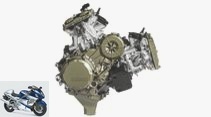
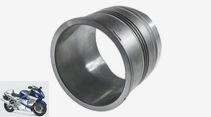
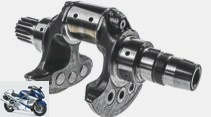
25th photos
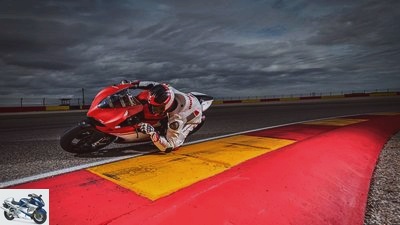
Ducati
1/25
Ducati 1299 Superleggera in the technology check.
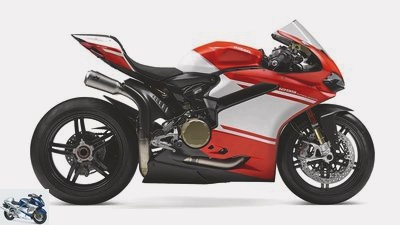
Ducati
2/25
Ducati 1299 Superleggera in the technology check.
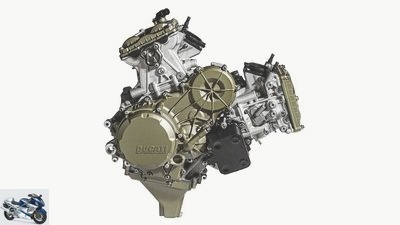
Ducati
3/25
The Superquadro engine weighs 2.1 kilos less than a 1299 series engine in its highest and probably last expansion stage and has an output of 215 hp.
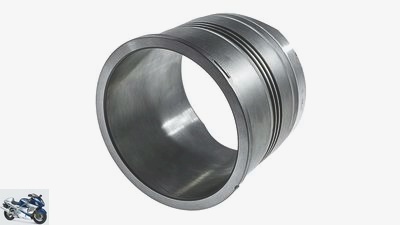
Ducati
4/25
Fine and high-quality materials as well as low tolerances make the 1299 SL-Twin what it is. In the picture: the new liners with aluminum alloy.
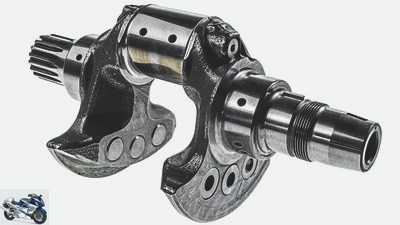
Ducati
5/25
The crankshaft carries counterweights made of high-strength tungsten, which is around 2.5 times heavier than steel.
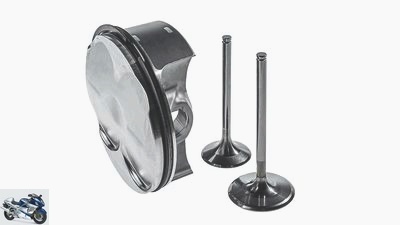
Ducati
6/25
The 1299 Superleggera features new titanium valves, titanium connecting rods and 116 pistons with only two piston rings.
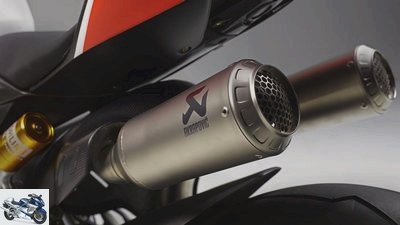
Ducati
7/25
Slovenian precious metal: The Akrapovic exhaust system made of titanium cites the shape of the WSBK machines and meets the Euro 4 approval standard. An optically identical, but not street-legal racing system is included. It increases the power of the 1299 SL by five to 220 hp.
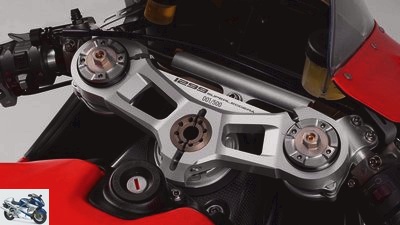
Ducati
8/25
Only 500 of the sinfully expensive machine were built. The production number is engraved on the fork bridge.
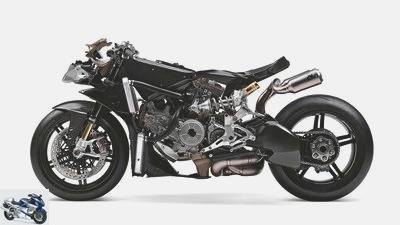
Ducati
9/25
Ducati 1299 Superleggera in the technology check.
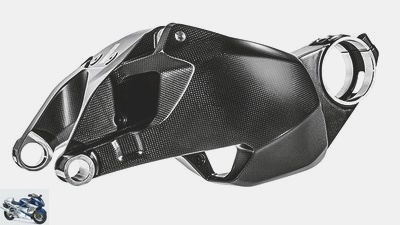
Ducati
10/25
The swing arm is the most complicated carbon part and was 900 grams lighter than the swing arm of the 1199 Superleggera.
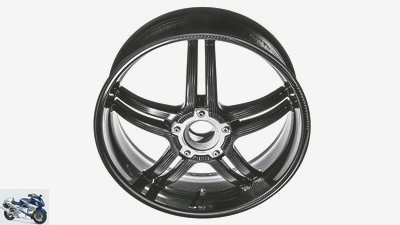
Ducati
11/25
At 5.5 kg, the carbon wheel weighs 1.4 kg less than a forged aluminum rim. In addition, the rolling resistance with the carbon wheel is more favorable, which has a significant effect on handling.
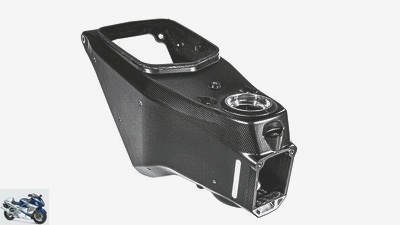
Ducati
12/25
Compared to the cast magnesium monocoque of the 1199 SL (3.6 kg), the carbon part of the 1299 SL is one kilo lighter.
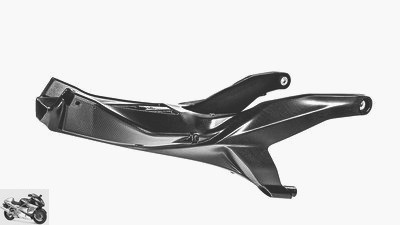
Ducati
13/25
The short rear frame weighs a mere 0.9 kilograms.
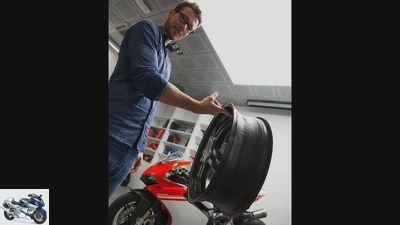
Ducati
14/25
The editor is amazed: The rear carbon wheel is lighter than the tire itself and can be easily balanced on the outstretched index finger.
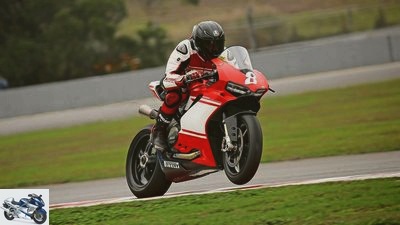
Ducati
15/25
In his wildcard appearance in the Chinese Superbike Championship, Alessandro Valia took the podium with the 1299 SL.
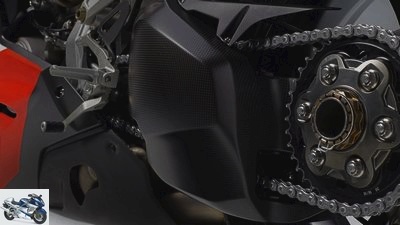
Ducati
16/25
Ducati 1299 Superleggera in the technology check.
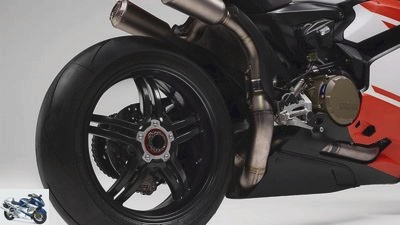
Ducati
17/25
Ducati 1299 Superleggera in the technology check.
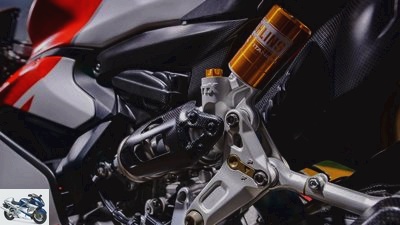
Ducati
18/25
Ducati 1299 Superleggera in the technology check.
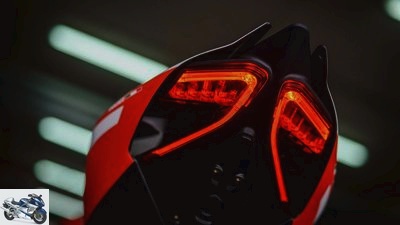
Ducati
19/25
Ducati 1299 Superleggera in the technology check.
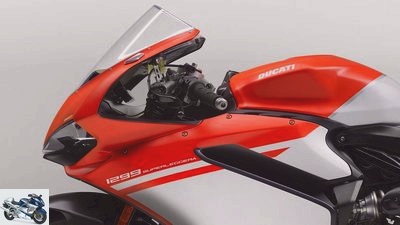
Ducati
20/25
Ducati 1299 Superleggera in the technology check.
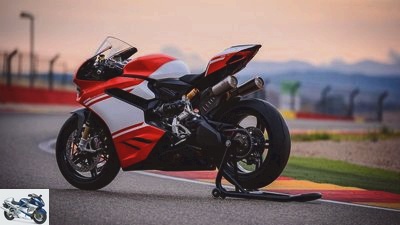
Ducati
21/25
Ducati 1299 Superleggera in the technology check.
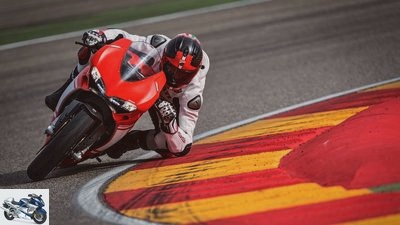
Ducati
22/25
Ducati 1299 Superleggera in the technology check.
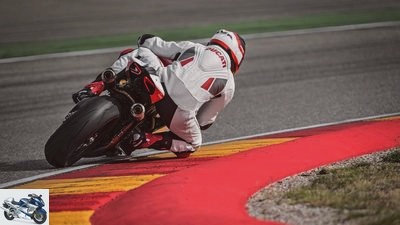
Ducati
23/25
Ducati 1299 Superleggera in the technology check.
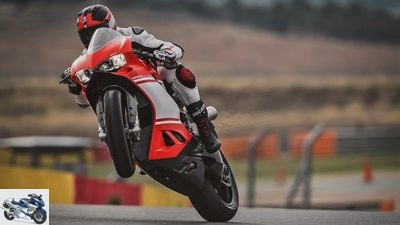
Ducati
24/25
Ducati 1299 Superleggera in the technology check.

Ducati
25/25
Ducati 1299 Superleggera in the technology check.
Ducati 1299 Superleggera technology check
Ducati’s quintessence
Content of
In Borgo Panigale they speak of "the bottom line" the brand itself. No street-legal Ducati has so far bundled more engineering skills than the Ducati 1299 Superleggera. PS met the development team on site for a technology check.
I.Inside the company’s headquarters near Bologna, you go up one floor and then down a corridor. On the left is Casey Stoner’s MotoGP racer, with which he won the 2007 World Championship. Behind it are the victorious 1098 R from Carlos Checa and various machines from Carl “Foggy” Fogarty.
Buy complete article

Ducati 1299 Superleggera technology check
Ducati’s quintessence
1299 Superleggera is the dream come true for every Ducatisti, every sports motorcycle lover and technology connoisseur. But even if you have almost 80,000 euros in play money lying around in the bank – the 1299 Superleggera, which is limited to 500 pieces, has long been sold out.
167 kg gross vehicle weight
As the successor to the 1199 Superleggera from 2014, the Ducati 1299 Superleggera pushes the limit further up. The Ducati development team worked on the machine for a good two years. In order to exploit the maximum of performance in several ways, the company relied on technologies that had not even been touched on in series motorcycle construction.
The entire cladding of the 1299 SL, the monocoque (2.6 kg), the rear frame (0.9 kg), the swing arm (4.2 kg) and the wheels (5.5 kg) are made of carbon. 167 kilograms of gross vehicle weight should bring the 167 kilograms of gross vehicle weight on the scales. About 20 kilos of the entire vehicle weight fall on carbon parts. Ducati does not want to reveal the names of the material suppliers, but the monocoque is produced in Germany, the wheels in South Africa, the rear frame in Italy and the cladding comes from Asia.
2 grams weight saving per development day
The most complicated part in production is the single-sided swing arm, explains project manager Christian Gasparri. Aluminum parts are also laminated into their carbon fiber mats. The component is used in a similar form by the MotoGP team. The Ducati Corse racing department incorporated a great deal of its know-how into this. First the rocker is baked in the autoclave (each carbon part goes through this process twice), then processed and in the last step painted over so as not to damage the material.
“Our carbon components are more complex than parts in the automotive industry because they are exposed to much more stress,” explains Gasparri. A non-destructive test procedure in three steps is used to ensure the quality of the material. Similar techniques are otherwise only found in space travel. Here is a small calculation example to highlight the developmental effort behind the carbon story: The team worked for a good two years on the Ducati 1299 Superleggera, whose swing arm is 900 grams lighter than that of the 1199 Superleggera. Two years of development roughly correspond to 440 working days. 900 grams divided by 440 working days equates to roughly two grams of weight savings per day.
First class handling, 215 hp, Euro 4
Test driver Alessandro Valia describes his experiences with the machine: “We were in Portimao, where some World Championship and BSB drivers were training at the same time. A certain Shakey Byrne was amazed when he was pulled by me at the exit of a corner on his Panigale R, with which he won the British Superbike Championship last year – on a street-legal bike with lighting and everything, “laughs Alessandro.
He sees the greatest advantage of the Ducati 1299 Superleggera SL compared to the 1199 SL in the handling. “With the carbon wheels, we were able to make a big leap in agility. As soon as I left the pit lane, I was amazed at how quickly the motorcycle turns. ”In Mugello, Valia drives the carbonated 1299 a good three seconds faster than the 1199 Superleggera. During the entire test and development drive, he threw the noble racer away only once per low-sider, says the likeable Italian with a wink.
First-class handling alone does not guarantee a fast lap time. Power has to sit there too! The Ducati 1299 Superleggera has an output of 215 hp, primarily due to the improved cylinder heads with modified intake ports, the sharper control times and the increased compression. Despite the increased performance and Euro 4 conformity, the Superquadro was 2.1 kilos lighter than the engine of a standard 1299 Panigale. All happy customers also received a racing exhaust system as an extra, which increases the output to 220 hp. Compared to the 1199 Superleggera, the new engine delivers twelve percent more power and torque at 6500 rpm. “You can feel that,” stresses Valia. If you had to put the value of the SL engine in figures, the price would be around 1.6 times as high as that of a Panigale R drive, estimates Andrea Cucculelli from the development team. Incidentally, despite the enormous power output, the standard service intervals are 12,000 kilometers.
Street-legal Ducati clears races
The electronic assistance systems have also been further developed and improved in the Ducati 1299 Superleggera. Depending on the driving situation, the traction control (DTC Evo) also intervenes via the throttle valve. This creates smoother transitions that even protect the tire. Thanks to a second IMU sensor box for recording the drift angle, Ducati Slide Control (DSC) could be implemented. It works in three stages and depending on the DTC. The DSC would be enormously helpful in developing a feeling for controlled drifts, explains Valia.
The lightning-fast Ducati test rider recently took part in a race of the Chinese Superbike Championship with the Ducati 1299 Superleggera by wildcard. Against well-known drivers like Broc Parkes, he took third place and missed victory by only a tenth of a second behind the leader – and all on a completely extraordinary machine with street legal, lights and activated ABS system.
Related articles
-
Ducati 1299 Superleggera driving report
Ducati 35 pictures Ducati 1/35 Ducati 1299 Superleggera. Ducati 2/35 Ducati 1299 Superleggera. Ducati 3/35 At the zenith of its power, the …
-
Ducati 1299 Superleggera (2017)
Motorcycle fair in Milan EICMA 2019 Presented by Ducati 17th photos Ducati 1/17 Ducati 1299 Superleggera. Ducati 2/17 Ducati 1299 Superleggera. Ducati…
-
Ducati Panigale V4 Superleggera: Up to 234 hp and 100,000 euros expensive
Ducati 35 pictures Ducati 1/35 Ducati brings a new V4 top model. leaked 2/35 The Superleggera celebrated its premiere on February 6, 2020. leaked 3/35 …
-
Ducati Panigale Superleggera V4 in the driving report
Ducati. 19 pictures Ducati. 1/19 We had the unique opportunity to try out the new Ducati Panigale Superleggera V4. Ducati. 2/19 Much closer …
-
Ducati 1199 Superleggera in the test
Jahn, Ducati 28 photos Jahn, Ducati 1/28 The Ducati technicians pulled out all the stops. If the listing of the changes in a new model is often a rather…
-
Presentation of the Ducati 1299 R Panigale Final Edition
Ducati 32 pictures Ducati 1/32 Ducati 1299 R Panigale Final Edition. Ducati 2/32 Ducati 1299 R Panigale Final Edition. Ducati 3/32 Ducati 1299 R Panigale …
-
Ducati 1299 Panigale S and Kawasaki Ninja H2 in comparison test
31 photos 1/31 On the left in the picture 197 PS and 145 Nm (Ducati 1299 Panigale S), on the right there are 200 PS and 133 Nm…
-
Generation comparison Ducati 1299 Panigale R Final Edition 2017 and Ducati 1199 Panigale from 2012
markus-jahn.de 27 photos markus-jahn.de 1/27 Generation comparison: 1199 Panigale vs. 1299 Panigale R Final Edition. markus-jahn.de 2/27 Generation…
-
Ducati 1299 Panigale S in the HP driving report
Ducati 26 pictures Ducati 1/26 Ducati 1299 Panigale S. Gluck 2/26 Ducati 1299 Panigale S. Gluck 3/26 Ducati 1299 Panigale S. Ducati 4/26 Ducati 1299 …
-
Driving report Ducati 1199 Superleggera
Ducati 23 pictures Ducati 1/23 Actually, it is unfair to water the reader’s mouth with a motorcycle that he cannot buy. ”So …